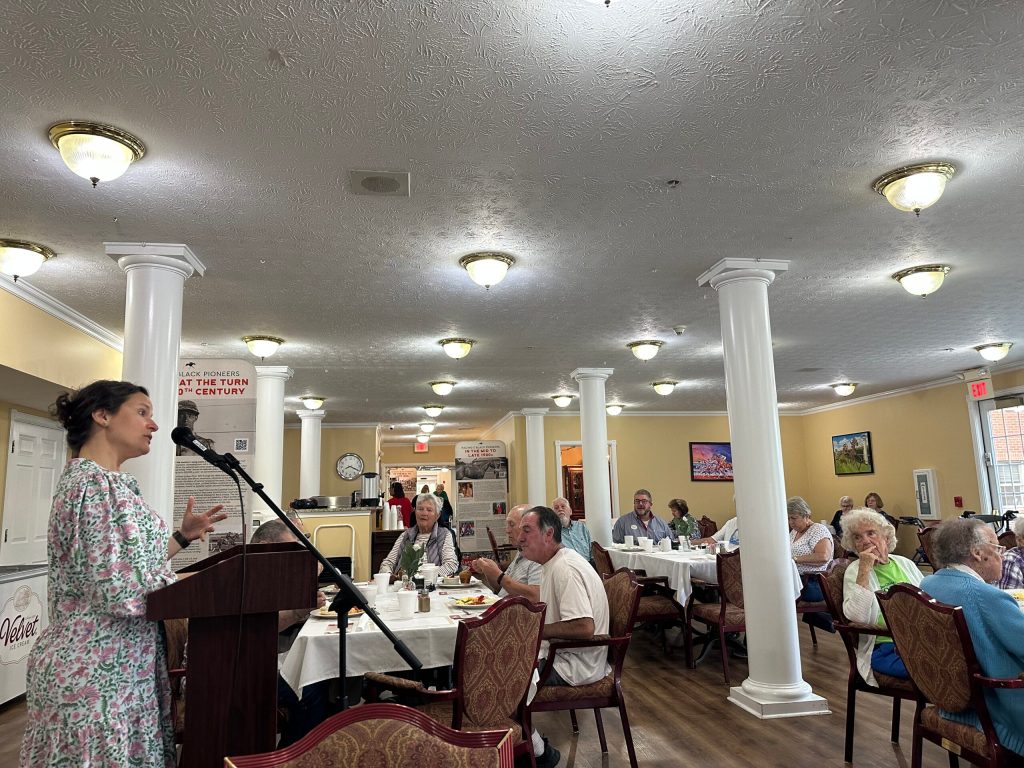Kenneland librarian discusses traveling exhibit at Brooks Place
Published 11:30 am Wednesday, August 21, 2024
|
Getting your Trinity Audio player ready...
|
In 2023, the Keeneland Library – associated with the well-known Keeneland Association, Inc. in Lexington – launched a groundbreaking exhibit titled “The Heart of the Turf: Racing’s Black Pioneers.”
With a goal in mind of informing the public about the lives and contributions of African American horsemen and women, it saw much fanfare.
Now a traveling exhibit, it was presented recently at Rose Mary C. Brooks Place just off Bypass Road with Keeneland Library Director Roda Ferraro speaking as well during a Wednesday morning breakfast.
“We’ve had the exhibit here for a week…they’re great panels with a lot of wonderful photos and history from that period of time,” said Rose Mary C. Brooks Place Executive Director Tim Janes. “We’re so appreciative that [Roda] is coming to speak with us.”
In highlighting the lives and careers of 80 African Americans from the mid 1800’s to the present, the exhibit includes photos and more, with biographical information further honoring their legacies.
Historically, Ferraro noted that southern states including Kentucky have always been a top place for the sport of horse racing.
Yet there’s more to be learned.
“What many people don’t know is what events led this region to be a hub for black horsemen, specifically in the years following the Civil War,” she said.
Thanks in part to the Kentucky Association, which existed from the late 1820s through 1933, Lexington’s East End neighborhood was home to many African Americans associated with horse racing along with their families.
Among them were Hall of Fame jockeys Isaac Burns Murphy and Jimmy Winkfield, trainer Ansel Williamson, and trainer and owner Edward Dudley Brown.
As can be expected, racism was an unfortunate issue.
“This is a tough topic to take on…there’s no doubt that the racing and breeding industries like all industries in this country have long standing race issues,” Ferraro said. “So much depended on when and where you were born in terms of the opportunities that you [had] in racing and breeding.”
Elaborating further, she expressed that – depending on factors such as gender as well – history would be quite different for some individuals.
“If you were an [African American] man born in…the mid-1800s, your exposure to this breeding history and racing history would have been from a very young age [being] enslaved”, she said. “If you were a woman born in that same period of time, and you [were] enslaved, you would have never worked with livestock. That simply would not have happened.”
Teaching historical perspective, Ferraro further added that – in the years before baseball and other sports – horse racing had much more prominence nationally.
“[Through] much of the 1800s – an entire century of this country’s history – racing is what people did. It was the national pastime. It was a national sport,” she said. “Nothing compared to the draw of the track.”
Over time, horse racing became the first major sport to be fully integrated, even during slavery.
For some, the chance to compete was especially rewarding.
In rare cases, a slave owner offered slaves their freedom on the condition of winning a particular race.
More often, however, financial rewards were provided as part of a deal.
“Interestingly, sometimes this [financial winning] was so extreme that that enslaved young man – 15 or 16 years old – may have more cash on his person than his owner,” Ferraro said. “That was the degree of wealth sometimes that we saw present with this…system of incentivizing jackets to do really well while they were enslaved.”
Due to his skills as a trainer, one African American in particular – Harry Lewis – was able to broker contracts with more than one of his prior owners.
Following the Civil War, progression continued, with many traveling the racing circuit as wives and families stayed home.
Still, opportunities could be slow to come by.
“Women, regardless of race, were not able to ride as jockeys until the late 1960s,” Ferraro said.
Thus, later changes – while benefiting African Americans – had additional impacts.
“The Civil Rights Movement and some of these changes that we see in this exhibit have much larger reaches and implications for people regardless of what they look like and their origins,” Ferraro added.
Presently, horse racing continues to be a top sport throughout the Commonwealth, a testament to its continuing legacy.
Opportunities to learn more about the contributions of African Americans to the horse industry and more, or wanting to host “The Heart of The Turf: Racing’s Black Pioneers” traveling exhibit, can visit heart-turf-racings-black-pioneers.






